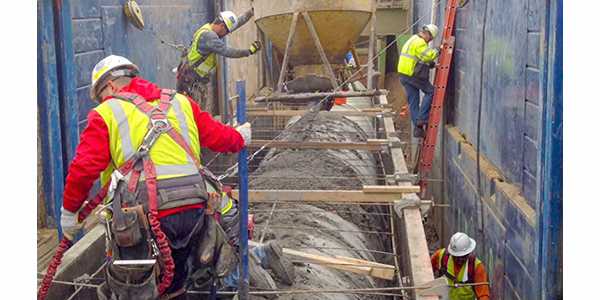QuickTakes Newsletter
June 18, 2025

COLLABORATING FOR SAFETY EXCELLENCE

By Amanda Wood Laihow, Acting Assistant Secretary of OSHA
This month, I was proud to congratulate the men and women of the U.S. Army Corps of Engineers' Caven Point Marine Terminal on achieving status in OSHA's Voluntary Protection Programs, our premier recognition for outstanding workplace safety and health programs.
At Caven Point, they have built a work environment where safety is valued, prioritized, and lived every day. Their proactive approach has created a safety culture where every employee, manager, administrator, and contractor, are invested in safety and health.
All elements of CPMT's safety and health management programs met the high quality expected of VPP participants, but more than that, they are also proactively working toward ongoing safety excellence. Their commitment to not simply meet safety standards but to also support and promote innovative preventive measures is exactly what makes a worksite worthy of joining the ranks of VPP.
If you are not familiar with the VPP, I encourage you to learn about the program and how we can work with you to establish a workplace culture in which everyone is invested in their safety and health.
UPCOMING EVENTS

June 1-30: National Safety Month
June 16-20: 2025 Trench Safety Stand Down
June 24: Virtual Meeting on the Globally Harmonized System of Classification and Labelling of Chemicals
July 30: National Whistleblower Day
August 11-17: Safe + Sound Week
BEAT THE HEAT: KNOW THE SIGNS

LAWNCARE AND LANDSCAPING SAFETY

Flowers and trees provide beauty and shade during summer, but the landscaping and horticultural service workers who maintain them face a wide variety of hazards, including exposure to chemicals, noise, machinery, lifting, and construction, as well as weather-related hazards, such as heat. Employers and workers should be aware of these potential hazards and solutions to ensure that everyone remains safe and healthy during the summer.
STAY SAFE WITH FORKLIFT TRAINING

Forklifts are used in many industries and can pose safety hazards for both the operators and others in the workplace. No one under 18 years of age may legally operate a forklift and adult workers must be properly trained and certified to operate forklifts. We have resources to help employers ensure that OSHA standards are followed and workers are protected from injury.
PREVENTING TRENCH HAZARDS WILL SAVE LIVES
The owner of a construction contracting business and one of his worksite supervisors recently pled guilty to second degree manslaughter following the cave-in of an unprotected trench that claimed the life of a worker. This case serves as a reminder of the hazards of unprotected trenches and the importance of proper trench safety measures.
Trench hazards are well-known and can be prevented by following OSHA's requirements to slope, shore or shield trench walls to prevent collapse. Taking the time to ensure that trenches are secure, and that workers are properly trained and equipped to work in them safely, can make the difference between life and death.
WORKING TOGETHER
For over 50 years, OSHA's On-Site Consultation Program has helped small- and medium-sized businesses protect workers and improve safety at no cost and with complete confidentiality. Launched in 1975, the program helps employers identify workplace hazards, improve safety practices, and build strong safety and health programs, all without triggering OSHA enforcement. A 2023 economic analysis estimated that these efforts generate $1.5 billion in national benefits annually through fewer injuries and illnesses, lower workers' compensation costs, and increased productivity.
YOU ASK...WE ANSWER

❓ What are OSHA's requirements for fireworks?
🗣 OSHA's Compliance Directive on Pyrotechnics provides instruction for the manufacture of, storage, safe handling, use, and display of fireworks. The Process Safety Management standard applies to the manufacture of fireworks, and the directive explains OSHA's other applicable requirements. Explosive materials that are staged for active use in the manufacturing or assembly process are not considered to be in “storage” and may be covered by the PSM standard.
WHAT'S TRENDING
Do you have a minute? Catch the latest news on what’s happening across OSHA and workplace safety and health.
QuickTakes subscribers occasionally receive DYK? bulletins about a single timely topic, resource or upcoming event.




